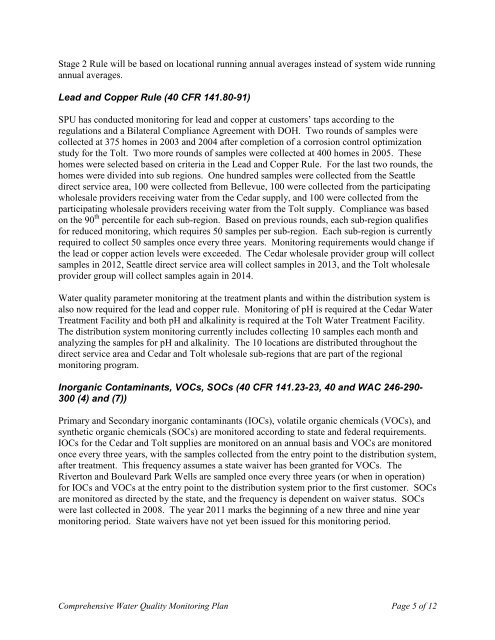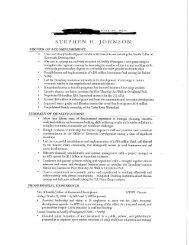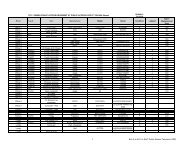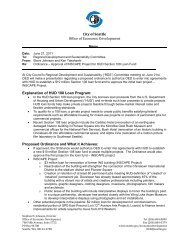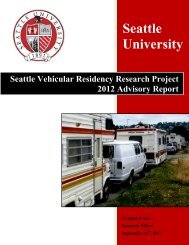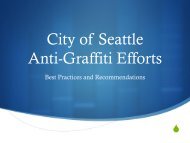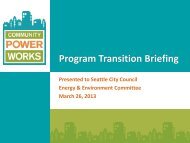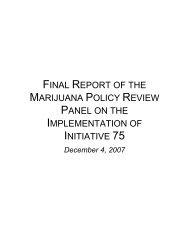2013 Water System Plan, Volume II - Seattle City Clerk's Office - City ...
2013 Water System Plan, Volume II - Seattle City Clerk's Office - City ...
2013 Water System Plan, Volume II - Seattle City Clerk's Office - City ...
Create successful ePaper yourself
Turn your PDF publications into a flip-book with our unique Google optimized e-Paper software.
Stage 2 Rule will be based on locational running annual averages instead of system wide running<br />
annual averages.<br />
Lead and Copper Rule (40 CFR 141.80-91)<br />
SPU has conducted monitoring for lead and copper at customers’ taps according to the<br />
regulations and a Bilateral Compliance Agreement with DOH. Two rounds of samples were<br />
collected at 375 homes in 2003 and 2004 after completion of a corrosion control optimization<br />
study for the Tolt. Two more rounds of samples were collected at 400 homes in 2005. These<br />
homes were selected based on criteria in the Lead and Copper Rule. For the last two rounds, the<br />
homes were divided into sub regions. One hundred samples were collected from the <strong>Seattle</strong><br />
direct service area, 100 were collected from Bellevue, 100 were collected from the participating<br />
wholesale providers receiving water from the Cedar supply, and 100 were collected from the<br />
participating wholesale providers receiving water from the Tolt supply. Compliance was based<br />
on the 90 th percentile for each sub-region. Based on previous rounds, each sub-region qualifies<br />
for reduced monitoring, which requires 50 samples per sub-region. Each sub-region is currently<br />
required to collect 50 samples once every three years. Monitoring requirements would change if<br />
the lead or copper action levels were exceeded. The Cedar wholesale provider group will collect<br />
samples in 2012, <strong>Seattle</strong> direct service area will collect samples in <strong>2013</strong>, and the Tolt wholesale<br />
provider group will collect samples again in 2014.<br />
<strong>Water</strong> quality parameter monitoring at the treatment plants and within the distribution system is<br />
also now required for the lead and copper rule. Monitoring of pH is required at the Cedar <strong>Water</strong><br />
Treatment Facility and both pH and alkalinity is required at the Tolt <strong>Water</strong> Treatment Facility.<br />
The distribution system monitoring currently includes collecting 10 samples each month and<br />
analyzing the samples for pH and alkalinity. The 10 locations are distributed throughout the<br />
direct service area and Cedar and Tolt wholesale sub-regions that are part of the regional<br />
monitoring program.<br />
Inorganic Contaminants, VOCs, SOCs (40 CFR 141.23-23, 40 and WAC 246-290-<br />
300 (4) and (7))<br />
Primary and Secondary inorganic contaminants (IOCs), volatile organic chemicals (VOCs), and<br />
synthetic organic chemicals (SOCs) are monitored according to state and federal requirements.<br />
IOCs for the Cedar and Tolt supplies are monitored on an annual basis and VOCs are monitored<br />
once every three years, with the samples collected from the entry point to the distribution system,<br />
after treatment. This frequency assumes a state waiver has been granted for VOCs. The<br />
Riverton and Boulevard Park Wells are sampled once every three years (or when in operation)<br />
for IOCs and VOCs at the entry point to the distribution system prior to the first customer. SOCs<br />
are monitored as directed by the state, and the frequency is dependent on waiver status. SOCs<br />
were last collected in 2008. The year 2011 marks the beginning of a new three and nine year<br />
monitoring period. State waivers have not yet been issued for this monitoring period.<br />
Comprehensive <strong>Water</strong> Quality Monitoring <strong>Plan</strong> Page 5 of 12


